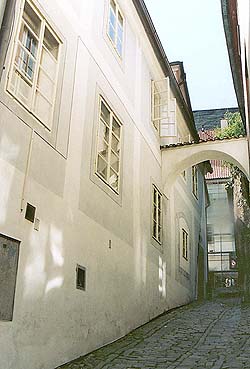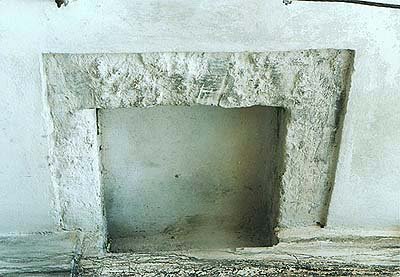Masná No. 139
Description of the Building:
One-storey building with a smooth facade into which leans a
prampouch vaulted over a valley. The ground floor layout contains a
hall with a flat ceiling and a staircase in the right part. In the
left part are also areas with flat ceilings. The first floor also
has flat ceilings.
Architectural and Historical Development:
The medieval origin of the house documents the entire character of
the structure, but it also has a significant architectural detail,
a Gothic cambered window with a stone dado, which is evidently from
the 15th century. Later, a right side was apparently added to the
house, in the front yard area of the neighbours, Horní
No. 144 and Horní
No. 145. In the 17th century, the house underwent a large
reconstruction, after it had apparently burned down. Another
reconstruction occurred in the 18th century when a new facade was
created, sectioned with pilaster strips. At first the strips were
painted, and later, as their present appearance shows, they were
plastic. The cellar was vaulted, and a right court wing was added
in a few stages. In 1867 the house burned down, and this wing was
allegedly only used as a ground floor. The second floor was built
in 1929.
Significant Architectural Features:
A Gothic cambered window.
History of the House Residents:
At the beginning of the 16th century the house belonged to Matha or
Macha. He was replaced by a cook, Hanzl. He died in 1521, and the
house was acquired by a shoemaker, Havel. Havel died some time
before 1531, when a widow, Voršila, sold the house to a butcher
Jiří Percl, who moved into the house from house No. 130, and in
addition to the house he also owned a butchery. In 1550 Václav
Petrlík, who previously resided in the house No. 2 on the square,
bought the house for 168 threescore of Meissen groschen. In 1553
Václav sold it for the same price to a penman, Vaněk Hodonský, who
originally lived in the house No. 6 on the square. During the next
hundred years the house was transferred without a book register, so
we have only fragmentary information about the residents from the
neighbouring locality. Vaněk died in 1563, and his widow Marta,
sold the house to Marx (Martin or Marek) Hacker, who died in 1587.
In the 1590`s the house belonged the a butcher, Kryštof Heinrich,
who married a cook named Mariana in 1598. His family resided in the
house until 1608 when a butcher, Kryštof Koch, moved in. In 1661
Markéta Truchtelfingerová, who owned the house since 1654, sold the
house to a carpenter, Jan Krössel. In 1684 the ownership of the
house was transferred to Tomáš Schillotzy who was also a carpenter.
He was replaced by Řehoř Handlhose in 1725. In 1737 the house
belonged to a goldsmith, Felix Leithner. In 1755 a draper, Jan
Tragau, bought the house. In 1782 the house went through an auction
because of Jan\'s debts. A butcher, Bernard Stifter, bought the
house in the auction, and in 1808 the house was inherited by his
son Antonín. In 1852 Antonie Stifterová, took care of the house
together with two barns and fields.
Present Use:
Residential house.



